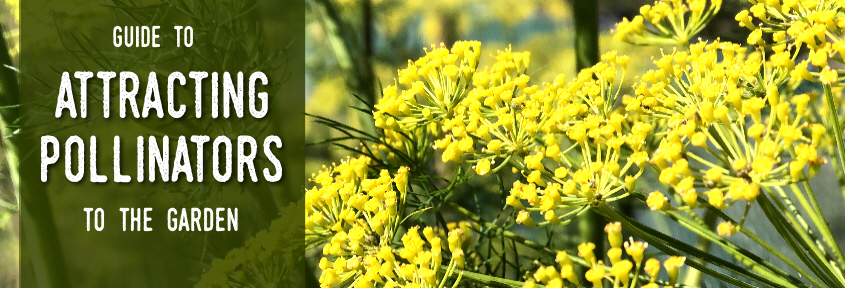
Creating an 'edible' pollinator haven
There's no question that pollinators - bees in particular - seem to be on the decline. In the aftermath of current attempts in Australia to eradicate the varroa mite with hive destruction and various other means, bee and other pollinator numbers definitely  seem to be dwindling. The effect this has on pollination in the garden can be significant with many growers feeling powerless to do anything. However there is something - albeit it very simple - any home gardener can do, with the creation of a pollinator garden which is designed to both attract and feed these pollinators. The added benefit is that you are also attracting beneficial insects to the garden which prey on garden pests.
seem to be dwindling. The effect this has on pollination in the garden can be significant with many growers feeling powerless to do anything. However there is something - albeit it very simple - any home gardener can do, with the creation of a pollinator garden which is designed to both attract and feed these pollinators. The added benefit is that you are also attracting beneficial insects to the garden which prey on garden pests.
The answer to all of this is simple - PLANT MORE FLOWERS! Or even better, incorporate edible flowers, flowering vegetables and flowering companion plants to create a garden which is not only pleasant to the eye but also EDIBLE!!!
POLLINATOR FACTS
- Flowers clustered in clumps or beds of at least 1 metre across are more attractive to pollinators than scattered individual flowers
- A succession of flowering plants that lasts from spring through to autumn and into winter will support a range of bee and pollinator species
- Flowers of different shapes will attract different types of pollinators
- Pesticides are a major threat to insect pollinators - use only natural and/or organic means
- Tiny clusters of flowers with exposed nectaries (think Queen Anne’s Lace) attract a wide variety of beneficial insects
- Many insects prefer flowers with a single row of petals over those that have two or more rows
- Tall groupings of plants provide insecdts with shelter from drying winds
- Pesticides are a major threat to insect pollinators - use only natural and/or organic means
With a large number of flowering vegetables available throughout the year, you don't need to wait for Spring to establish an edible pollinator garden. The time to start is NOW!
For growers in the southern or highland areas of Australia where winters are cold, pollinators largely rely on blooming trees in spring with wattles amongst the first to bloom, but cool season and early-blooming flowering plants provide additional resources. Mid and late-blooming plants are useful during the growing season and also heading into the winter months.
Those in remaining parts of Australia can ensure continued supply by continual planting of all categories.
A continual planting of all plants will ensure adequate food supply and attract beneficial insects to your garden.
EARLY BLOOMING POLLINATOR PLANTS:
Chives (companion plant to carrot, parsley, tomato)
Clover (companion plant to fruit trees)
Dianthus
Lupin
Mustards (companion plant to all fruit trees)
Parsley (companion plant to asparagus, carrot, chives, tomato)
Pea (companion plant to broccoli, brussel sprouts, cabbage, carrots, cauliflower, celery, lettuce, parsnip, potato, radish)
Alyssum (companion plant to all fruit trees)
Viola
Rocket (companion plant to bean, beetroot, celery, cucumber, dill, lettuce, nasturtium, onion, potato, rosemary, spinach)
Chamomile (companion plant to cucumber, onion)
Sage (companion plant to cabbage, carrots, tomato)
Radish (companion plant to pea, lettuce, bean, carrot, kohl rabi, parsnip, onion, mustard, nasturtium, cucumber, spinach)
MID SEASON POLLINATOR PLANTS:
Basil (companion plant to asparagus, fennel, tomato, cucumber)
Borage (companion plant to tomato, strawberry, squash, zucchini, pumpkin)
Buckwheat
Butterfly Pea
Calendula (companion plant to bean, potato)
Coriander (companion plant to potato, broccoli, brussel sprouts, cabbage, carrot, cauliflower, dill, parsnip)
Echinacea
Cosmos
Dill (companion plant to cabbage, broccoli, brussel sprouts)
Squash (companion plant to radish, corn, peas, bean, pumpkin, marigold, nasturtium, zucchini)
Pumpkin (companion plant to bean, nasturtium, radish, corn)
Thyme (companion plant to cabbage)
Clary Sage
Fennel (companion plant to bean, caraway, coriander, dill, tomato)
Nasturtium (companion plant to broccoli, brussel sprouts, cabbage, cauliflower, squash, pumpkin, zucchini, marrow, kale, kohl rabi, radish, tomato, potato)
Oregano (companion plant to cabbage, cucumber, all plants)
Sunflower (companion plant to squash, cucumber, zucchini, pumpkin)
Tomatillo
LATE BLOOMING POLLINATOR PLANTS:
Rocket (companion plant to bean, beetroot, celery, cucumber, dill, lettuce, nasturtium, onion, potato, rosemary, spinach)
Coriander (companion plant to potato, broccoli, brussel sprouts, cabbage, carrot, cauliflower, dill, parsnip)
Cosmos
Dill (companion plant to cabbage, broccoli, brussel sprouts)
Gourd (companion plant to bean, mint, nasturtium, radish, corn)
Pumpkin (companion plant to bean, nasturtium, radish, corn)
Squash (companion plant to radish, corn, peas, bean, pumpkin, marigold, nasturtium, zucchini)
Amaranth (companion plant to cucumber, corn, bean, tomato, potato, capsicum, chilli, eggplant, pea, marigold)
Sunflower (companion plant to squash, cucumber, zucchini, pumpkin)
